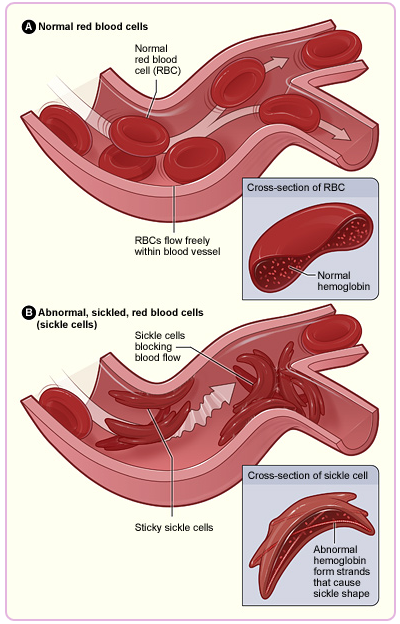Sickle Cell Screening

If you are of African, Middle Eastern, Mediterranean, Caribbean, or Asian descent, you may carry the sickle cell trait. If both parents carry it, your baby may have sickle cell anemia, which could lead to certain complications or death if left untreated.
What is Sickle Cell Anemia?
If you are of African, Middle Eastern, Mediterranean, Caribbean, or Asian descent, you may carry the sickle cell trait. If both parents carry it, your baby may have sickle cell anemia, which could lead to certain complications or death if left untreated.
Sickle cell anemia (uh-NEE-me-uh) is a serious disease in which the body makes sickle-shaped red blood cells. "Sickle-shaped" means that the red blood cells are shaped like a "C."
Normal red blood cells are disc-shaped and look like doughnuts without holes in the center. They move easily through your blood vessels. Red blood cells contain the protein hemoglobin (HEE-muh-glow-bin). This iron-rich protein gives blood its red color and carries oxygen from the lungs to the rest of the body.
Sickle cells contain abnormal hemoglobin that causes the cells to have a sickle shape. Sickle-shaped cells don't move easily through your blood vessels. They're stiff and sticky and tend to form clumps and get stuck in the blood vessels. (Other cells also may play a role in this clumping process.)
The clumps of sickle cells block blood flow in the blood vessels that lead to the limbs and organs. Blocked blood vessels can cause pain, serious infections, and organ damage.
Figure A shows normal red blood cells flowing freely in a blood vessel. The inset image shows a cross-section of a normal red blood cell with normal hemoglobin.
Figure B shows abnormal, sickled red blood cells clumping and blocking blood flow in a blood vessel. (Other cells also may play a role in this clumping process.) The inset image shows a cross-section of a sickle cell with abnormal hemoglobin.
Overview
Sickle cell anemia is one type of anemia. Anemia is a condition in which your blood has a lower than normal number of red blood cells. This condition also can occur if your red blood cells don't have enough hemoglobin.
Red blood cells are made in the spongy marrow inside the large bones of the body. Bone marrow is always making new red blood cells to replace old ones. Normal red blood cells last about 120 days in the bloodstream and then die. They carry oxygen and remove carbon dioxide (a waste product) from your body.
In sickle cell anemia, a lower-than-normal number of red blood cells occurs because sickle cells don't last very long. Sickle cells usually die after only about 10 to 20 days. The bone marrow can't make new red blood cells fast enough to replace the dying ones.
Sickle cell anemia is an inherited, lifelong disease. People who have the disease are born with it. They inherit two copies of the sickle cell gene - one from each parent.
People who inherit a sickle cell gene from one parent and a normal gene from the other parent have a condition called sickle cell trait. Sickle cell trait is different from sickle cell anemia. People who have sickle cell trait don't have the disease, but they have one of the genes that cause it. Like people who have sickle cell anemia, people who have sickle cell trait can pass the gene to their children.
Outlook
Sickle cell anemia affects millions of people worldwide. The disease has no widely available cure. However, there are treatments for the symptoms and complications of the disease. Bone marrow transplants may offer a cure in a small number of cases.
Over the past 30 years, doctors have learned a great deal about sickle cell anemia. They know its causes, how it affects the body, and how to treat many of its complications.
Sickle cell anemia varies from person to person. Some people who have the disease have chronic (long-term) pain or fatigue (tiredness). However, with proper care and treatment, many people who have the disease can have improved quality of life and reasonable health much of the time.
Due to improved treatment and care, many people who have sickle cell anemia are now living well into their sixties.
 PREGNANCY
PREGNANCY  GIVING BIRTH
GIVING BIRTH  BABY CARE
BABY CARE  HEALTH & SAFETY
HEALTH & SAFETY  FUN STUFF
FUN STUFF  FAMILY
FAMILY 